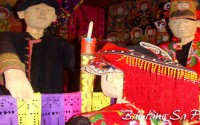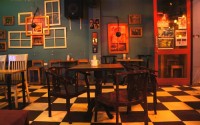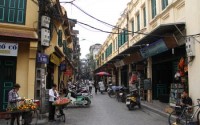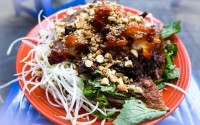Where to eat when you have a trip in Vietnam
At Audley, our specialists have local knowledge about the top vietnam places to visit. Find out where we recommend for your next tailor-made trip.
Broadly speaking, there are two types of eating establishment to choose from. One step up from hawkers peddling their dish of the day from shoulder poles or handcarts are street kitchens – inexpensive joints aimed at locals. More formal, Western-style restaurants come in many shapes and sizes, from simple places serving unpretentious Vietnamese meals to top-class establishments offering high quality Vietnamese specialities and international cuisine.
While most eating establishments stay open throughout the year, some close over Tet. The Vietnamese eat early: outside the major cities and tourist areas; food stalls and street kitchens rarely stay open beyond 8pm and may close even earlier, though they do stay open later in the south, especially in Ho Chi Minh City and da lat vietnam. You’ll need to brush up your chopstick-handling skills, too, although other utensils are always available in places frequented by tourists – in Western-style restaurants you won’t be expected to tackle your steak-frites with chopsticks.
When it comes to paying, the normal sign language will be readily understood in most restaurants. In street kitchens you pay as you leave – either proffer a few thousand dong to signal your intentions, or ask bao nhieu tien? (“how much is it?”). As with accommodation, prices are listed in dollars throughout the guide but exchange rates may be wildly different by the time you travel and the smaller, local establishments often prefer to be paid in dong.
Street kitchens
Eating on the street may not be to every visitor’s taste, but those willing to take the plunge usually put it up among their favourite experiences in the country – the food is often better in quality to that found at restaurants, it’s much cheaper, and a whole lot more fun. Street kitchens range from makeshift food stalls, set up on the street round a cluster of pint-size stools, to eating houses where, as often as not, the cooking is still done on the street but you either sit in an open-fronted dining area or join the overspill outside. Both tend to have fixed locations, though only the eating houses will have an address – which usually doubles as their name. Some places stay open all day (7am–8pm), while many close once they’ve run out of ingredients and others only open at lunchtime (10.30am–2pm). To be sure of the widest choice and freshest food, it pays to get there early (as early as 11.30am at lunchtime, and by 7pm in the evening), and note that the best places will be packed around noon.
Most specialize in one type of food, generally indicated (in Vietnamese only) on a signboard outside, or offer the ubiquitous com (rice dishes) and pho (noodle soups). Com binh dan, “people’s meals”, are also popular. Here you select from an array of prepared dishes displayed in a glass cabinet or on a buffet table, piling your plate with such things as stuffed tomatoes, fried fish, tofu, pickles or eggs, plus a helping of rice; expect to pay from around 25,000? for a good plateful. Though it’s not a major problem at these prices, some street kitchens overcharge, so double-check when ordering.
Though eating street food is highly recommended, it’s worth using a bit of judicious selection – look for places with a fast turnover, where the ingredients are obviously fresh. A bit of basic vocabulary will certainly help.
In a similar vein to street kitchens are bia hoi outlets. Though these are primarily drinking establishments, many provide good-value snacks or even main meals.
Restaurants
If you’re after more relaxed dining, where people aren’t queuing for your seat, then head for a Western-style Vietnamese restaurant (nha hang), which will have chairs rather than stools, a name, a menu and will often be closed to the street. In general these places serve a more varied selection of Vietnamese dishes than the street kitchens, plus a smattering of international – generally European – dishes.
Menus at this level usually show prices, particularly in areas popular with tourists. If there are no prices on your menu, confirm them with staff before you start eating to avoid any potential overcharging issues. Prices vary considerably depending upon what you order, but you’ll get a modest meal for less than $5 per head. Opening hours at such places are usually from 10.30am to 2pm for lunch, and in the evening from 5pm to no later than 9pm, or 8pm in the north.
In the main tourist haunts, you’ll find cheap and cheerful cafés aimed at the backpacker market and serving often mediocre Western and Vietnamese dishes – from burgers and banana pancakes to spring rolls, noodles and other Vietnamese standards. They have the advantage, however, of all-day opening, usually from 7am to 11pm or midnight. And, should you crave a reasonably priced Western-style breakfast, fresh fruit salad or a mango shake, these are the places to go.
As you move up the price scale, the decor and the cuisine become more sophisticated and the menu more varied. The more expensive restaurants (including the smarter hotel dining rooms) tend to stay open later in the evening, perhaps until 9.30pm or 10.30pm. Some have menus priced in dollars, and more and more accept credit cards. Usually menus indicate if there’s a service charge, but watch out for an additional 3–4 percent on credit card payments. These restaurants can be relatively fancy places, with at least a nod towards decor and ambience, and correspondingly higher prices (a meal for two is likely to cost at least $20 and often much more).
The most popular foreign cuisine on offer is French, though both Hanoi and Ho Chi Minh City boast some pretty good international restaurants, including Thai, Chinese, Tex Mex, Indian and Italian. You’ll find these international cuisines, and upper-class Vietnamese restaurants, in Hanoi, Ho Chi Minh City, Hué, Da Nang, Hoi An and Nha Trang, though they’re scarce in the rest of the country.
Read more: temple of literature : Vietnam’s firstnational university









